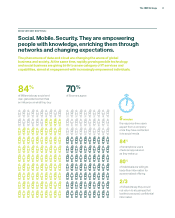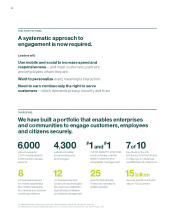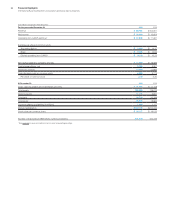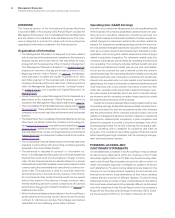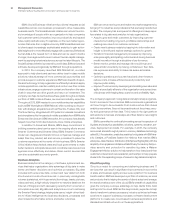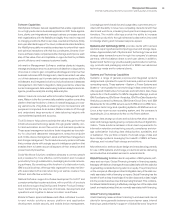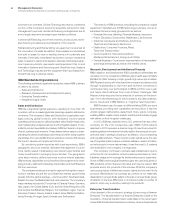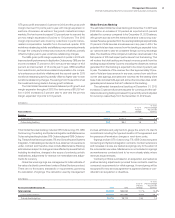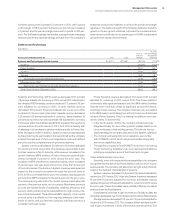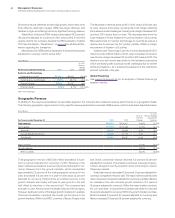IBM 2013 Annual Report Download - page 31
Download and view the complete annual report
Please find page 31 of the 2013 IBM annual report below. You can navigate through the pages in the report by either clicking on the pages listed below, or by using the keyword search tool below to find specific information within the annual report.30 Management Discussion
International Business Machines Corporation and Subsidiary Companies
IBM’s Social Business initiative helps clients integrate social
capabilities across core business processes to drive measurable
business results. The Social Business initiative can unlock the intrin-
sic knowledge of people within an organization to help companies
fuel customer-centric innovation, improve productivity and expand
sales, loyalty and advocacy. To capitalize on the new market oppor-
tunities that arise from a digital economy, IBM Social Business can
let clients apply increasingly sophisticated analytics to gain action-
able insight and to more effectively engage with customers. Behavioral,
human data is the newest form of data and can be used to build a
stronger, more agile workforce and reinvent human capital manage-
ment by applying behavioral sciences across the talent lifecycle. The
Social Business initiative is powered by world class IBM services and
software, developed organically by IBM and through acquisitions.
In 2013, the company launched IBM MobileFirst, a unified
approach to help clients and partners deliver best-in-class mobile
solutions, take advantage of more commercial opportunities and
provide a superior customer experience. IBM has a breadth of exper-
tise and technology to help organizations efficiently build and deploy
mobile applications, maintain visibility and control over their mobile
infrastructure, engage customers in context and transform the value
chain in ways that can drive growth and return on investment. The
company can help its clients achieve these goals through a complete
portfolio of IBM mobile software, services and industry expertise.
Throughout 2013, IBM invested in core mobile enterprise capabilities
such as IBM Worklight and IBM Rational, while rounding out its port-
folio with strategic acquisitions such as Fiberlink, Trusteer, Xtify and
The Now Factory. Integrated with 270 patents in wireless innovations
and strengthened by thousands of mobile specialists from IBM Mobile
Enterprise Services and IBM Interactive, the company has already
helped more than 1,000 clients become more mobile enterprises.
In addition to Social and Mobile, IBM’s deep commitment to
building a smarter planet can be seen in the ongoing efforts around
Smarter Commerce and Smarter Cities. IBM’s Smarter Commerce
model can integrate and transform how companies manage and
adapt their buy, market, sell and service processes to place the
customer experience at the center of their business. IBM’s Smarter
Cities initiative helps federal, state and local governments to make
better decisions, anticipate issues and coordinate resources across
agencies more effectively and deliver citizen-centric services that
can drive sustainable economic growth.
Business Analytics
Business Analytics is the category of software, systems and ser-
vices that helps organizations take advantage of big data to make
better and faster decisions and optimize processes. Big data
includes both enterprise data, content and new data from both
structured and unstructured sources: in previously unimaginable
volumes (petabytes), with huge variety (from blogs, tweets, pictures,
videos and text), at high velocity (machine-to-machine data from the
Internet of things) and with decreasing veracity (from uncertain or
incomplete sources). Big data and analytics are core to achieving
the Smarter Planet strategy, helping data-savvy, insight-driven lead-
ers to infuse intelligence into business decisions, processes and
client interactions for faster actions and better outcomes.
IBM can serve new buyers and make new market segments by
bringing IT to industries and professions that are being transformed
by data. The company has a unique set of offerings and deep exper-
tise related to big data and analytics to help organizations:
• Acquire, grow and retain customers by improving customer
interactions, building long-term, profitable relationships and
realizing new value from customer sentiment.
• Create new business models by tapping into information and
insight to identify and explore strategic options for growth.
• Transform financial management processes by improving
enterprise agility, anticipating outcomes and driving business
model innovation through a discipline of performance.
• Better monitor, predict and manage risk to build trust and
value amidst uncertainty, by having confidence in their data,
risk exposures and ability to make risk-aware actionable
decisions.
• Optimize operations and counter fraud and other threats to
reduce costs, increase efficiencies and productivity and
improve public safety.
• Improve IT economics by developing and enabling new value and
agility at practically all levels of the organization and across lines
of business while helping keep costs low and profitability high.
The company’s approach to big data and analytics helps organiza-
tions to succeed in their industries. IBM recommends organizations
do three things to be successful. First, build a culture that infuses
analytics everywhere. Second, be proactive about the privacy, secu-
rity and governance of their data. Third, invest in the right platform
and solutions to harness and analyze all of their data for new insights
and outcomes.
IBM is committed to continually innovating across the spectrum of
big data and analytics capabilities, solutions, systems, research, ser-
vices, deployment and skills. For example, in 2013, the company
announced a breakthrough dynamic in-memory database technology
called BLU Acceleration, predictive analytics for big data with IBM Ana-
lytic Catalyst, a PureData System for Hadoop that marries IBM’s
enterprise-class Hadoop distribution (InfoSphere BigInsights) with the
simplicity of an appliance, InfoSphere Data Privacy for Hadoop that pro-
vides security and protection for sensitive big data, a Watson
Engagement Advisor solution to help transform how brands and their
customers interact and new academic partnerships to help prepare
students for the expanding scope of careers in big data and analytics.
Cloud Computing
Cloud is a model for consuming and delivering business and IT
services that can result in significant improvements in economies
of scale and business agility and serve as a platform for business
transformation. IBM has developed a portfolio of solutions, services
and products that is helping thousands of clients adopt and leverage
the transformative power of the cloud. IBM’s breadth of capabilities
gives the company a unique advantage to help clients think, build
and tap into the cloud. IBM has the deep industry expertise to help
clients transform business processes, industry optimized software
solutions to support business processes, software development
platforms to create new cloud-based business applications and
standardized infrastructure to run these applications.



